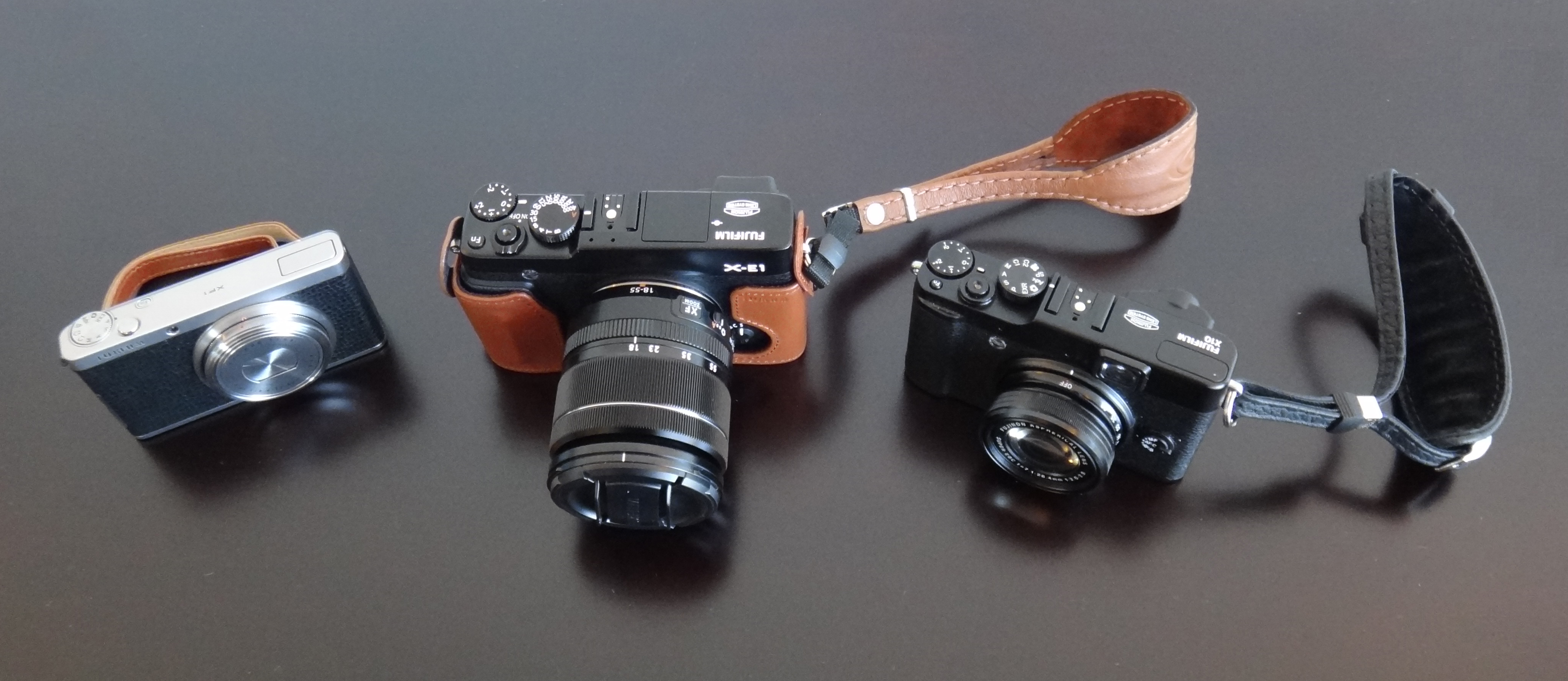|
Fujifilm GFX100
The Fujifilm GFX100 is a mirrorless medium format camera produced by Fujifilm. It is the flagship model of the GFX Series of mirrorless digital cameras and the third camera with the Fujifilm G-mount. The camera comes in two versions, the regular GFX100 and the GFX100 IR. The GFX100 won the Japanese 2020 Camera Grand Prix ( :ja:カメラグランプリ) Editors Award. GFX100 On September 25, 2018, the GFX 100Megapixels Concept was unveiled at Photokina 2018. The camera was launched on May 23, 2019, for release in late June 2019. The camera has a back-illuminated sensor with phase detection pixels. The sensor is 1.7 times the size of a 35 mm full-frame sensor. The camera uses the in-body image stabilization (IBIS) mechanism with 5-axis stabilization, and has 4K/30P video recording capability using the full sensor without cropping. It has twin battery packs, dual SD slots, twin status LCDs, a tri-axial 3.2" monitor, USB charging and power delivery over USB C and a removab ... [...More Info...] [...Related Items...] OR: [Wikipedia] [Google] [Baidu] |
Fujifilm
, trading as , or simply Fuji, is a Japanese Multinational corporation, multinational Conglomerate (company), conglomerate headquartered in Tokyo, Japan, operating in the areas of photography, optics, Office supplies, office and Biomedical engineering, medical electronics, biotechnology, and Chemical substance, chemicals. The company started as a manufacturer of photographic films, which it still produces. Fujifilm products include document solutions, medical imaging and diagnostics equipment, cosmetics, Medication, pharmaceutical drugs, regenerative medicine, stem cells, Contract manufacturing organization, biologics manufacturing, magnetic tape data storage, Optical coating, optical films for flat-panel displays, Optical instrument, optical devices, photocopiers, printers, digital cameras, Color photography, color films, color paper, Photographic processing, photofinishing and graphic arts equipment and materials. Fujifilm is part of the Sumitomo Mitsui Financial Group financia ... [...More Info...] [...Related Items...] OR: [Wikipedia] [Google] [Baidu] |
Lithium-ion Battery
A lithium-ion or Li-ion battery is a type of rechargeable battery that uses the reversible intercalation of Li+ ions into electronically conducting solids to store energy. Li-ion batteries are characterized by higher specific energy, energy density, and energy efficiency and a longer cycle life and calendar life than other types of rechargeable batteries. Also noteworthy is a dramatic improvement in lithium-ion battery properties after their market introduction in 1991; over the following 30 years, their volumetric energy density increased threefold while their cost dropped tenfold. In late 2024 global demand passed per year, while production capacity was more than twice that. The invention and commercialization of Li-ion batteries has had a large impact on technology, as recognized by the 2019 Nobel Prize in Chemistry. Li-ion batteries have enabled portable consumer electronics, laptop computers, cellular phones, and electric cars. Li-ion batteries also see signifi ... [...More Info...] [...Related Items...] OR: [Wikipedia] [Google] [Baidu] |
Fujifilm GFX100S
The Fujifilm GFX100S is a mirrorless medium format camera produced by Fujifilm with Fujifilm G-mount. It is a smaller version of the 2019 GFX100 camera. The camera was announced by the corporation on January 27, 2021 at the X Summit Global 2021 together with the X-E4. Sales began in March 2021. The camera uses a 102MP 43.8 x 32.9 mm medium format sensor with 100% phase-detection autofocus coverage. It also has a Pixel Shift Multi-Shot capability, allowing the camera to move its sensor to create ultra-high resolution 400MP images. The GFX100S uses a smaller and lighter in-body image stabilization (IBIS) mechanism with 5-axis stabilization than its predecessor GFX100. It is capable of recording 4K video using the full sensor and can also transfer raw video to an external recorder. Compared to the GFX100, the GFX100S is 500 g lighter, 30 percent smaller, with no interchangeable EVF, and no option for a vertical battery grip. The controls feature a traditional DSLR-style dial, as w ... [...More Info...] [...Related Items...] OR: [Wikipedia] [Google] [Baidu] |
Fujifilm X100
The Fujifilm X100 is a series of digital compact cameras with a fixed prime lens. Originally part of the FinePix line, then becoming a member of the X series from Fujifilm, the X100 series includes the FinePix X100, X100S, X100T, X100F, X100V, and X100VI. They each have a large image sensor and a 23 mm lens (35 mm equivalent angle of view in full frame format). All six cameras have received generally positive reviews. The Fujifilm FinePix X100 was initially shown at the Photokina show in September 2010 and was subsequently introduced in February 2011. It was the first model in the Fujifilm X-series of cameras and has since been joined by numerous models. It is superseded by the Fujifilm X100S. Fujifilm FinePix X100 The FinePix X100, the original model in the line, was introduced in 2011. This was the first camera in what would grow to become the Fujifilm X series although that designation came later. The X100 is a rangefinder-style camera. Key features * 12.3 MP, APS-C si ... [...More Info...] [...Related Items...] OR: [Wikipedia] [Google] [Baidu] |
Fujifilm X Camera
The Fujifilm X series is a line of digital cameras produced by Fujifilm. The series encompasses fixed lens and interchangeable lens mirrorless cameras and premium compact point-and-shoot cameras aimed at consumer, enthusiast and professional photographers. The X series is part of the larger FinePix range of digital cameras from Fujifilm. The X series models use APS-C, one inch, or inch sensors. X series model lines Since its introduction with the X100 in 2011, the X series has grown to encompass a wide variety of designs. These lines can be broken out into the following categories or model lines. APS-C sensor The following lines are united by their use of APS-C-sized sensors measuring 23.5×15.6 mm, with an aspect ratio of 3:2 and Ø31.15 mm field diameter. They are listed here within each category in the order in which the initial model of each type was introduced. Fixed lens * X100 line — These models have a fixed focal length 23mm prime lens and a hybrid elec ... [...More Info...] [...Related Items...] OR: [Wikipedia] [Google] [Baidu] |
Bluetooth 4
Bluetooth is a short-range wireless technology standard that is used for exchanging data between fixed and mobile devices over short distances and building personal area networks (PANs). In the most widely used mode, transmission power is limited to 2.5 milliwatts, giving it a very short range of up to . It employs UHF radio waves in the ISM bands, from 2.402GHz to 2.48GHz. It is mainly used as an alternative to wired connections to exchange files between nearby portable devices and connect cell phones and music players with wireless headphones, wireless speakers, HIFI systems, car audio and wireless transmission between TVs and soundbars. Bluetooth is managed by the Bluetooth Special Interest Group (SIG), which has more than 35,000 member companies in the areas of telecommunication, computing, networking, and consumer electronics. The IEEE standardized Bluetooth as IEEE 802.15.1 but no longer maintains the standard. The Bluetooth SIG oversees the development of the specifi ... [...More Info...] [...Related Items...] OR: [Wikipedia] [Google] [Baidu] |
Wi-Fi 5
IEEE 802.11ac-2013 or 802.11ac is a wireless networking standard in the IEEE 802.11 set of protocols (which is part of the Wi-Fi networking family), providing high-throughput wireless local area networks (WLANs) on the 5 GHz band. The standard has been retroactively labelled as Wi-Fi 5 by Wi-Fi Alliance. The specification has multi-station throughput of at least 1.1 gigabit per second (1.1 Gbit/s) and single-link throughput of at least 500 megabits per second (0.5 Gbit/s). This is accomplished by extending the air-interface concepts embraced by 802.11n: wider RF bandwidth (up to 160 MHz), more MIMO spatial streams (up to eight), downlink multi-user MIMO (up to four clients), and high-density modulation (up to 256-QAM). The Wi-Fi Alliance separated the introduction of 802.11ac wireless products into two phases ("waves"), named "Wave 1" and "Wave 2". From mid-2013, the alliance started certifying Wave 1 802.11ac products shipped by manufacturers, based on the ... [...More Info...] [...Related Items...] OR: [Wikipedia] [Google] [Baidu] |
USB-C
USB-C, or USB Type-C, is a 24-pin reversible Electrical connector, connector (not a Communication protocol, protocol) that supersedes previous USB hardware#Connectors, USB connectors (also supersedes Mini DisplayPort and Lightning (connector), Lightning connectors) that can transfer data, e.g. audio/video data, to connect to monitors, external drives, mobile phones, keyboards/mouses, and many more peripheral devices; sometimes indirectly via hubs/docking stations. It also exchanges electricity, in general to power peripheral devices. It is used not only by USB technology, but also by other data transfer protocols, including Thunderbolt (interface), Thunderbolt, PCIe, HDMI, DisplayPort, and others. It is Extensibility, extensible to support future protocols. The design for the USB-C connector was initially developed in 2012 by Intel, HP Inc., Microsoft, and the USB Implementers Forum. The Type-C Specification 1.0 was published by the USB Implementers Forum (USB-IF) on August 11 ... [...More Info...] [...Related Items...] OR: [Wikipedia] [Google] [Baidu] |
HDMI
High-Definition Multimedia Interface (HDMI) is a proprietary digital interface used to transmit high-quality video and audio signals between devices. It is commonly used to connect devices such as televisions, computer monitors, projectors, gaming consoles, and personal computers. HDMI supports uncompressed video and either compressed or uncompressed digital audio, allowing a single cable to carry both signals. Introduced in 2003, HDMI largely replaced older analog video standards such as composite video, S-Video, and VGA connector, VGA in consumer electronics. It was developed based on the CEA-861 standard, which was also used with the earlier Digital Visual Interface (DVI). HDMI is electrically compatible with DVI video signals, and adapters allow interoperability between the two without signal conversion or loss of quality. Adapters and active converters are also available for connecting HDMI to other video interfaces, including the older analog formats, as well as digital fo ... [...More Info...] [...Related Items...] OR: [Wikipedia] [Google] [Baidu] |
Audio Jack
A phone connector is a family of Cylinder, cylindrically-shaped electrical connectors primarily for Analog signal, analog audio signals. Invented in the late 19th century for Telephone switchboard, tele''phone'' switchboards, the phone connector remains in use for interfacing wired audio equipment, such as Headphone, head''phones'', Loudspeaker, speakers, Microphone, micro''phones'', mixing consoles, and electronic musical instruments (e.g. electric guitars, Electronic keyboard, keyboards, and effects units). A Gender of connectors and fasteners, ''male'' connector (a plug), is mated into a ''female'' connector (a socket), though #Other terms, other terminology is used. Plugs have 2 to 5 electrical contacts. The tip contact is indented with a groove. The sleeve contact is nearest the (conductive or Insulator (electricity), insulated) handle. Contacts are insulated from each other by a band of non-conductive material. Between the tip and sleeve are 0 to 3 ring contacts. Since ... [...More Info...] [...Related Items...] OR: [Wikipedia] [Google] [Baidu] |
1080p
1080p (1920 × 1080 progressively displayed pixels; also known as Full HD or FHD, and BT.709) is a set of HDTV high-definition video modes characterized by 1,920 pixels displayed across the screen horizontally and 1,080 pixels down the screen vertically; the ''p'' stands for progressive scan, ''i.e.'' non- interlaced. The term usually assumes a widescreen aspect ratio of 16:9, implying a resolution of 2.1 megapixels. It is often marketed as Full HD or FHD, to contrast 1080p with 720p resolution screens. Although 1080p is sometimes referred to as 2K resolution (meaning having a horizontal resolution of approximately 2,000 pixels), other sources differentiate between 1080p and (true) 2K resolution. 1080p video signals are supported by ATSC standards in the United States and DVB standards in Europe. Applications of the 1080p standard include television broadcasts, Blu-ray Discs, smartphones, Internet content such as YouTube videos and Netflix TV shows and movi ... [...More Info...] [...Related Items...] OR: [Wikipedia] [Google] [Baidu] |



